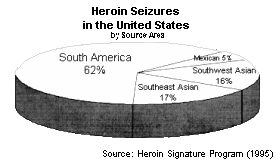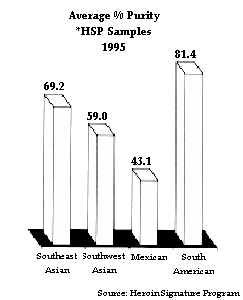Drug Enforcement Administration
Briefing Book
![]() DRCNet Response to the
DRCNet Response to the
Drug Enforcement Administration
Briefing Book
DRCNet Response: Heroin has long been the bogeyman of American drug policy. In order to properly understand the current situation, we recommend that readers start by reading the first dozen chapters of the Consumers Union Report on Licit and Illicit Drugs, which does a good job of summarizing the history and problems of heroin.
| DEA Statement | Response |
 |
|
| Heroin reaches the United States from four major source areas: Southeast Asia (principally Burma); Southwest Asia/Middle East (Afghanistan, Turkey, Pakistan and Lebanon); Mexico; and South America. Heroin was readily available in the United States in 1995. Wholesale prices were stable, and purities were high, indicating that international supplies had increased. | The DEA notes that heroin comes from all over the world and that international supplies have increased. They fail to note that the US illegal market could be adequately supplied with about one percent of the total world production. Thus, even if supplies had decreased, there is no real hope that it would have any long-term effect on the illegal market in the US. |
| Traditionally, ethnic Chinese and Nigerian traffickers have smuggled large amounts of high purity heroin from Southeast Asia for distribution in the northeastern United States and along the eastern coast. Mexican black tar heroin was prevalent in the West, Southwest and Midwest. Limited quantities of Southwest Asian heroin were available in the Northeast and Midwest, and to a lesser extent on the West Coast. South American heroin was principally smuggled into the U.S. East Coast. At the current time, heroin from South America (Colombia) acounts for 62% of the heroin seized in the United States. This is a major change from previous years, when Southeast Asian heroin was the predominant type of heroin found in the United States. |
The change came primarily because the cocaine sellers in South America discovered the tremendous profits available in another illegal drug. |
| Nationally, in 1995, Southeast Asian heroin ranged in price from $70,000 to $260,000 per kilogram. Southwest Asian heroin ranged from $70,000 to $260,000 per kilogram. Wholesale-level prices for Mexican heroin at the bottom end of the range were the lowest of any type, selling for as low as $50,000. South American heroin sold for between $80,000 and $185,000. The wide range in kilogram prices reflected variables such as buyer-seller relationships, quantities purchased, purchase frequencies, and transportation costs. |
In the heroin maintenance clinics in Europe, heroin can be prescribed to addicts at very low cost. See, for example, the descriptions of the Swiss heroin maintenance clinics on the Lindesmith Center web site. |
| On the street, heroin purity is directly related to availability. During 1995, the nationwide average purity for retail heroin from all sources was 39.7%, much higher than the average of 7% a decade ago, and considerably higher than the 26.6% recorded in 1991. The rise in average purity corresponded directly to the increase in availability of high-purity South American and Southeast Asian heroin. | Obviously, by the DEA's own statements, the increased effort put toward stopping heroin over the last several years has not succeeded. |
| Heroin Use: The 1995 National Household Survey on Drug Abuse estimated that 1.4 million people have used heroin in their lifetime. This estimate was about twice as large as the 1994 estimate. Although the change was statistically significant only for the 35 and older age group, estimates for other age groups were also higher in 1995 than in 1994, including youths age 12-17. | By the DEA's own words, this policy is failing the worst among the 12-17
age group -- precisely the age group that is most likely to develop long-term problems if
they begin using drugs. Some observers have commented that, without the millions of marijuana users to cloud the issue of "drugs" and "drug users", the relatively small number of people who have used heroin in their lifetime would certainly not justify the hysterical campaigns against it, and the huge resources allotted to the DEA and their cohorts. |


Travel back to the DRCNet Response to the DEA Home Page
Travel back to the DRCNet List of DEA Publications
Travel back to the Table of Contents